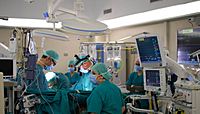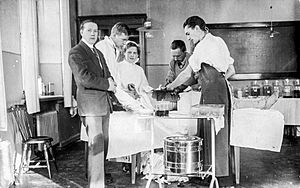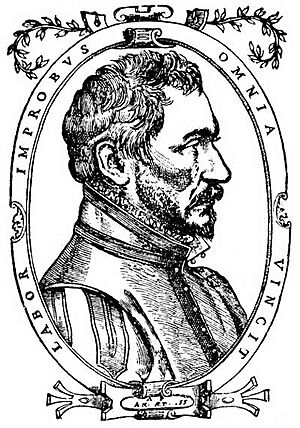Surgery facts for kids
Surgery is a special part of medicine or dentistry. It uses tools and hands-on methods to help people. Surgeons might investigate or treat a health problem like a disease or injury. They can also improve how a body part works or looks, or fix parts that are broken.
When someone performs surgery, it's called a surgical procedure or an operation. A surgeon is a doctor who performs surgery. A surgical team includes the surgeon, a surgeon's assistant, an anaesthetist (who helps with pain), and nurses. Surgery usually takes minutes to hours. It's not a treatment that happens all the time. The word "surgery" can also mean the place where operations happen. In some places, it can even mean a doctor's office.
Contents
What is Surgery?
Surgery is a method where doctors physically work on organs, body systems, or tissues. They do this to find out what's wrong or to fix a problem.
A procedure is usually called surgery if it involves cutting a person's tissues. It can also be surgery if it closes a wound that happened before. Other procedures, like looking inside the body with a camera (endoscopy), might also be called surgery. This is true if they use a sterile (very clean) environment, special tools, or medicine to prevent pain (anesthesia).
Kinds of Surgery
Surgical procedures are grouped in different ways. This can be by how urgent they are, what kind of procedure it is, which body part is involved, or what tools are used.
- By how urgent it is:
- Elective surgery is planned ahead of time. It fixes problems that are not life-threatening.
- Semi-elective surgery is needed to prevent serious problems. But it can be delayed for a short time.
- Emergency surgery must be done right away. It saves a life or prevents serious harm.
- By what it's for:
- Exploratory surgery helps doctors find or confirm a diagnosis.
- Therapeutic surgery treats a problem that doctors already know about.
- Cosmetic surgery aims to make a normal body part look better.
- By the type of procedure:
- Amputation means cutting off a body part, like a leg or a finger.
- Resection is removing all or a main part of an internal organ.
- Excision is cutting out only a part of an organ or tissue.
- Replantation means reattaching a body part that was cut off.
- Reconstructive surgery rebuilds an injured or deformed body part.
- Transplant surgery replaces a body part with one from another person or animal. Taking an organ from a donor for transplant is also surgery.
- By body part:
Surgery can be named after the body part it's done on. For example, cardiac surgery is on the heart. Orthopedic surgery is on bones or muscles.
- By how invasive it is:
- Minimally-invasive surgery uses small cuts. Tiny tools are put inside the body. An example is laparoscopic surgery.
- Open surgery uses a large cut to reach the area.
- By equipment used:
- Laser surgery uses a laser instead of a scalpel to cut tissue.
- Microsurgery uses a microscope to help the surgeon see tiny parts.
- Robotic surgery uses a special robot controlled by the surgeon.
Surgical Words
Many surgical words have special endings that tell you what kind of procedure it is:
- Words ending in -ectomy mean cutting out an organ or tissue.
- Words ending in -otomy mean cutting into an organ or tissue. For example, a laparotomy is cutting into the belly.
- Words ending in -oscopy mean looking inside the body with a small camera.
- Words ending in -ostomy mean creating a new, permanent opening in the body.
- Words ending in -oplasty mean rebuilding or reshaping a body part. For example, rhinoplasty is nose surgery.
- Words ending in -rraphy mean repairing a damaged or abnormal structure.
How Surgery Happens
Where Surgery Takes Place
Inpatient surgery happens in a hospital. The person stays at least one night after the operation. Outpatient surgery means the person goes home the same day. This can be at a hospital or a special surgery center. Some minor surgeries can even happen in a doctor's office.
In a hospital, modern surgery happens in an operating theater. This room has special tools, an operating table, and other equipment. Everything in the operating room must be very clean to prevent germs. This is called aseptic technique. All tools are sterilized (made germ-free). The surgical team wears special clothes, masks, and sterile gloves. They also wash their hands and arms very well before each surgery.
Before Surgery
Before surgery, the person has a medical check-up and some tests. If everything looks good, they sign a consent form. This form says they understand and agree to the surgery. If a lot of blood might be lost, the person might donate their own blood a few weeks before. If the surgery is on the digestive system, they might need to clean out their bowels the night before. People are also told not to eat or drink anything after midnight before surgery. This helps prevent problems with medicine and vomiting.
Doctors usually don't do routine X-rays or blood tests unless there's a good reason. These tests are only done if they can help doctors understand the risks of surgery.
Getting Ready for Surgery
In the waiting area, the person changes clothes and confirms details about their surgery. Nurses check their vital signs (like heart rate and blood pressure). An IV line (a small tube in a vein) is placed. They might get medicine like antibiotics or sedatives (to help them relax).
When the person enters the operating room, the skin where the surgery will happen is cleaned with a special germ-killing liquid. If there's hair, it's clipped off. The person is helped into a specific position for the surgery. Sterile cloths are placed around the area to keep it clean.
Medicine called anesthesia is given to prevent pain. Depending on the surgery, it can be:
- Local anesthesia: Only a small area is numbed. The person stays awake.
- Spinal anesthesia: A larger area is numbed, but the person can stay awake or lightly sedated.
- General anesthesia: The person is made unconscious and can't feel anything. They are given a breathing tube and a machine helps them breathe.
The goal of choosing the right surgery and anesthesia is to lower risks, speed up recovery, and reduce stress on the body.
During Surgery
The "intraoperative phase" is the time when the surgery is actually happening. It starts when the person enters the operating room and ends when they go to the recovery area.
First, the surgeon makes a cut to reach the area. Blood vessels might be clamped or sealed to stop bleeding. Special tools are used to hold the cut open. Sometimes, several layers of tissue need to be cut through. In some cases, bone might be cut, like the skull for brain surgery. Throughout the surgery, the team uses very clean methods to prevent infection. Surgeons and assistants wash their hands and arms thoroughly and wear sterile gloves and masks.
Then, the doctors work to fix the problem. This can involve:
- Cutting out an organ, tumor, or other tissue.
- Partially removing an organ or body part.
- Reconnecting organs or tissues, especially if they were cut.
- Moving a body part back to its normal position, like a broken bone.
- Tying off blood vessels or tubes.
- Adding grafts: Pieces of tissue from the same body or another person/animal are used to rebuild or repair. For example, in bypass surgery, a new blood vessel is used to go around a clogged one.
- Inserting artificial parts like pins, screws, or artificial hips.
- Creating an opening in the body.
- Inserting a donor organ in transplant surgery.
- Joining bones together so they grow into one.
- Modifying the digestive system for weight loss.
- Repairing problems like hernias or tears.
- Clearing clogged tubes or removing stones.
- Draining built-up fluids.
- Removing dead or damaged tissue.
Sometimes, blood transfusions are given if a lot of blood is lost. Once the work is done, the cut is closed with stitches or staples. Then, the anesthesia is stopped, and the person is woken up and helped to breathe on their own.
After Surgery
After surgery, the person goes to a recovery room. Nurses watch them closely. Once they have recovered from the anesthesia, they either go to a hospital room or go home. During recovery, doctors check how the person is doing and look for signs of infection at the surgery site.
Sometimes, small tubes called drains are put in to remove blood or fluid from the wound. These stay in until the fluid stops draining.
After surgery, people might need more treatment. This could be medicine, physical therapy, or other follow-up care. Doctors sometimes use antibiotics on wounds to prevent infection.
Pain is common after surgery. Doctors work to manage this pain so people can recover more comfortably. Full recovery takes time and effort, and people are often not fully recovered when they leave the hospital.
Surgery for Older People
Older adults have different health levels. Frail older people (those who are weaker or have more health issues) have a higher risk of problems after surgery. They might need more care. Doctors check older people before surgery to guess how well they will recover.
History of Surgery
Surgery has been around for a very long time, even in prehistoric times.
Ancient Times
- Trepanation: One of the oldest surgeries was drilling a hole in the skull. This was done to treat problems like pressure in the head.
- Ancient Egypt: About 3500 years ago, Egyptians performed surgeries. They used stitches to close wounds and honey to treat infections.
- India: Evidence shows teeth were drilled 9,000 years ago. An ancient Indian surgeon named Sushruta is called the "father of surgery." He wrote one of the oldest surgical texts. It described many procedures, including plastic surgery.
- Ancient Greece: Temples were places for healing. Doctors like Galen performed complex surgeries, even on the brain and eyes.
Islamic World
During the Islamic Golden Age, a doctor named Al-Zahrawi was very important. He invented many surgical tools. He was the first to describe some procedures, like breast reduction and thyroid removal. He also pioneered brain and nerve surgery.
Early Modern Europe
In Europe, surgeons began to study formally at universities. Andreas Vesalius in the 1500s showed that surgeons should learn by doing dissections themselves. Ambroise Paré, a French army surgeon, found better ways to treat wounds and stop bleeding during amputations.
Modern Surgery
Modern surgery began to develop scientifically. John Hunter in Scotland (1700s) is called the father of modern scientific surgery. He used experiments to learn about the body and surgery. He understood the importance of preventing infection. He believed surgery should be a last resort.
Other important surgeons in the 1700s and 1800s made discoveries about bone diseases and new surgical methods.
Pain Control
A huge change came in the mid-1800s with the discovery of anesthesia. Before this, surgery was very painful. Surgeons had to work as fast as possible. With anesthesia, like ether and chloroform, patients no longer felt pain. This allowed doctors to do more complex operations inside the body.
Stopping Infection
Even with anesthesia, many people died from infections after surgery. In 1847, a Hungarian doctor named Ignaz Semmelweis found that handwashing stopped infections. But many doctors didn't believe him.
Later, in the 1860s, British surgeon Joseph Lister learned about germs from Louis Pasteur. Lister realized that germs caused infections. He started spraying carbolic acid on his tools to kill germs. This greatly reduced infections. He then developed even better ways to prevent germs from getting into wounds. This led to sterile surgery, where everything is kept germ-free. Lister introduced steam sterilizers for equipment, strict handwashing, and rubber gloves.
These three big steps – scientific methods, anesthesia, and sterile equipment – made modern surgery possible. In 1895, X-rays were discovered. They became an important tool for doctors to see inside the body without cutting.
Images for kids
See also
 In Spanish: Cirugía para niños
In Spanish: Cirugía para niños









